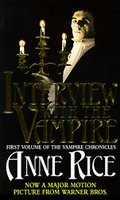
The vampire genre seems to be very popular at the moment, but it always has been. I think it safe to say that there are more vampire movies than any other specific genre. Yet the resurgence over the last few years has been phenomenal. Is this all down to a blonde vampire slayer?
“Buffy the Vampire Slayer” was a series that ran seven seasons from 1997 to 2003, and spawned a five-season spin-off series, “Angel”. It came from a 1992 feature movie, than in all fairness was a flop – though I must admit I do have a soft spot for the movie. Despite the title, Buffy was not entirely concerned with vampires; she fought against a plethora of demons and supernatural beings and relied on the “boggle effect”. The “boggle effect” is where something is so weird that the observer’s mind chooses not to see it. This was used to good effect by the writers, disbelief did not need to be suspended too far as the writers intimated that all this was really occurring, but ordinary folks simply refused to see it. The series was also aided by some sharp writing, though occasionally hindered by a tendency to drift towards the maudlin and, certainly in later seasons, the inclusion of some very whiney characters (Dawn, we look to you – though in the series the writers actually confronted this tendency when the character Willow became evil and confronts Dawn about her endless stream of low grade angst).
Love it or hate it, it is clear that Buffy will have had some impact on the number of vampire movies and books being produced, indeed its influence (along with the X-files) can be seen in the sheer number of paranormally based TV series. However, was it the only influence?
There has been a slough of, what we could call, phenomena books but I shall concentrate on one of the more popular series. The Anita Blake novels by Laurell K Hamilton are very popular. They centre on Blake, a feisty brunette who is a state authorised vampire executioner. To all intents and purposes this sounds very Buffyish. Unlike Buffy, Blake is not a chosen one and has no intense strength. As we meet her she is not only the executioner, but also a raiser of zombies. She does gain in power as the series develops, but this power stems from her relationship with a vampire, Jean-Claude, and a werewolf, Richard. The gain in power also seemed to coincide with Hamilton’s plots loosing place to much more erotic fiction – these books are aimed fairly and squarely at an adult market. In the books, in a premise quite different to that of Buffy, the supernatural is very much a part of modern society. Vampires are out of the closet. Anita raises zombies to settle testate issues and lycanthropes are finding that they face discrimination in the workplace due to their conditions.
In the books, in a premise quite different to that of Buffy, the supernatural is very much a part of modern society. Vampires are out of the closet. Anita raises zombies to settle testate issues and lycanthropes are finding that they face discrimination in the workplace due to their conditions.
However, the temptation is to state that Blake owed all to Buffy (and I think here I am referring to the series and forgetting the movie). However the first book, “The Laughing Corpse”, was published in 1994, some three years before the series aired. The increasing popularity of the series might tie in with the phenomenal popularity of the Slayer, but Hamilton created her own franchise that is very popular in its own right. Another major influence on the genre has been through the books of Anne Rice. Starting with “Interview with the Vampire” published in 1976, the impact of Rice’s work cannot be underestimated. However, as popular as Rice’s “Vampire Chronicles” are, they did bring to the fore the syndrome of the whinging vampire. The character Louis redefines misplaced angst, as does Marius in the later book “Blood and Gold”. The upshot of this is a trend for vampires unhappy with their lot in life, tortured and moody. Hmm… Sounds very much like Angel from the Buffy franchise. This development is not, necessarily a good one as vampires (in my opinion) are at their best when they revel in their condition – hence Spike being a much better character in Buffy – however it does indicate the amount of influence Rice has had.
Another major influence on the genre has been through the books of Anne Rice. Starting with “Interview with the Vampire” published in 1976, the impact of Rice’s work cannot be underestimated. However, as popular as Rice’s “Vampire Chronicles” are, they did bring to the fore the syndrome of the whinging vampire. The character Louis redefines misplaced angst, as does Marius in the later book “Blood and Gold”. The upshot of this is a trend for vampires unhappy with their lot in life, tortured and moody. Hmm… Sounds very much like Angel from the Buffy franchise. This development is not, necessarily a good one as vampires (in my opinion) are at their best when they revel in their condition – hence Spike being a much better character in Buffy – however it does indicate the amount of influence Rice has had.
As much influence that Buffy and series such as “Vampire Chronicles” and “Anita Blake” may have had, however, they pale into insignificance compared to the influence that Dracula has had. Since its publication the book has not been out of print, there are studies of the book printed, novels as prequels, sequels and re-writes. The character Dracula has been in more movies than you can reasonably shake a stick at. “Bram Stoker’s Dracula” (1992) is a point in case, with a screenplay based on the novel and then a further novellisation of the screenplay by Fred Saberhagen, which whilst it might be useful from a collector’s point of view was probably one of the most unnecessary novellisations ever.
“Dracula” is so influential that, even when the character is not part of a story he is often mentioned in unrelated stories. This is often because it is clear that the writer cannot conceive of a world where the name Dracula is not known to one and all. Anne Rice mentions the book in the screenplay of “Interview with the Vampire” (1994), Louis brands the book “the vulgar fictions of a demented Irishman.” Similarly, in the movie Midnight Kiss (1993) the cops joke about putting an APB out on Dracula. In Buffy, Dracula himself makes a guest appearance.
The influence of Buffy has been great, and it certainly has kept the  genre in the limelight. Yet it is not the only modern influence on the genre and shows such as Buffy, plus novel series such as those created by Rice and Hamilton both influence and popularise the genre. However none can hold a light to “Dracula”, whose influence seems to stretch through the centuries like a distorted shadow with a will of its own.
genre in the limelight. Yet it is not the only modern influence on the genre and shows such as Buffy, plus novel series such as those created by Rice and Hamilton both influence and popularise the genre. However none can hold a light to “Dracula”, whose influence seems to stretch through the centuries like a distorted shadow with a will of its own.
Thursday, March 30, 2006
The Buffy Syndrome
Posted by
Taliesin_ttlg
at
10:06 AM
![]()
Subscribe to:
Post Comments (Atom)
















4 comments:
The holy trinity of vampire influence is Dracula, Nosferatu, and Vampire Chronicles. Buffy might have some influence, but in my opinion it doesn't differ enough from Anne Rice. The mythology is, aside from the slayer line idea, completely ingulfed in Anne Rice.
Dracula brought us the undead and its religious symbolism, Nosferatu set the mythological rules that are now standard, and Rice gave us the gothic link that too is standard. Buffy is just a comedy-drama series that is a product of its influences. I still love the show and am sure many future artists will be influenced by it, but it doesn't really add much to the vampire genre that didn't already exist...
Mateo, to a degree that was the point. Though I don't know how Ricean Buffy was - other than Angel, and he is RRicean because of his soul - the vamp demon aspect is there I guess, though it is handled very differently.
One thing Buffy has definitely introduced is the concept of "dusting". Whilst vampire movies did have crumbling to dust before, the fast dusting of Buffy is something that film makers have taken and adopted into the genre.
Incidently, whilst Nosferatu is very influential (no arguing with that) it is really a sub-group of the Dracula influence, being based on Dracula as it is.
Dusting is part of Vampire Chronicles too, but only when exposed to sunlight. I guess its true that Buffy introduced instant dusting and dusting under all forms of death, however how influencial has this been? What movies or books have adopted this?
I think Buffy is heavily influenced by Rice. If you think Angel is Louis, then isn't it also true that Spike is Lestat? And I think the idea of vampire companionship is something that has to be directly linked with Vampire Chronicles.
As for Nosferatu being a subgroup of Dracula, I disagree because I think it differs to too strong of a degree. You almost never see vampires today who turn into wolves or mist or walk around in sunlight. Occassionally but not too often (Sea of Red, the comic I recommended to you a while back uses the misting). I think the genre would have been drastically different with Nosferatu.
I actually would have included Universal's Dracula series with the others, because I think it had major influence for a while, but Rice came along and now pretty much everything adopts her gothic styling. So I don't see the Universal influence as much these days. But I think this is kind of a good thing, because I think the influence was turning Dracula into too much of a cartoon character, which is what has happened to Frankenstein's Monster for the same reason.
Instant dusting is what I meant, and the most obvious choice is Blade - which came out in the same year as Buffy though the effects I'm thinking of were best used in Blade 2. The new 'Salem's Lot also has a form of it (including shooting up through the ceiling on death!)
I agree with you generally, I was trying to say that whilst Buffy has had an influence it tends to be keeping the genre popular - and yes Spike would be the Lestat equivalent I guess.
By saying Nosferatu is a subgenre of Dracula I mean that it was based (roughly) on the novel, thus no Stoker, no Nosferatu - though it has its own style and I agree that the genre would have been drastically different if that model had been used.
Universal did have an influence for a while and so did Hammer (and Hammer's influence is probably still there).
BTW, tommorow I'll be reviewing Way of the Vampire. I mention because of the comment you made about wolves and bats. The film mentions that vampires can turn into wolves and bats but then doesn't actually show any such changes!
Finally, many thanks for the comments, its good to get debate going and I really do appreciate it.
Post a Comment